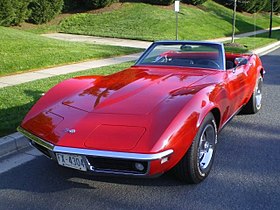Chevrolet Corvette (C3)
| Chevrolet Corvette (C3) | |
|---|---|

1968 Chevrolet Corvette Convertible
|
|
| Overview | |
| Manufacturer | Chevrolet (General Motors) |
| Also called | Chevrolet Corvette Stingray (1969–1976) |
| Production | 1968–1982 |
| Model years | 1968–1982 |
| Assembly |
|
| Designer |
|
| Body and chassis | |
| Class | Sports car |
| Body style |
|
| Layout | FR layout |
| Powertrain | |
| Engine |
|
| Transmission |
|
| Dimensions | |
| Wheelbase | 98.0 in (2,489 mm) |
| Length |
|
| Width |
|
| Height |
|
| Curb weight | 3,520 lb (1,597 kg) |
| Chronology | |
| Predecessor | Chevrolet Corvette (C2) |
| Successor | Chevrolet Corvette (C4) |
The Chevrolet Corvette (C3) was a sports car that was produced by Chevrolet for the 1968 through 1982 model years. Engines and chassis components were mostly carried over from the previous generation, but the body and interior were new. It set new sales records with 53,807 produced for the 1979 model year. The C3 is the third generation of the Chevrolet Corvette, while the 1969 through 1976 models mark the second generation of the Corvette Stingray.
The Corvette C3 was patterned after the Mako Shark II designed by Larry Shinoda. Executed under Bill Mitchell's direction, the Mako II had been initiated in early 1964. Once the mid-engined format was abandoned the Shinoda/Mitchell car was sent to Chevrolet Styling under David Holls, where Harry Haga's studio adapted it for production on the existing Sting Ray chassis. The resulting lower half of the car was much like the Mako II, except for the softer contours. The concept car's name was later changed to Manta Ray. The C3 also adopted the "sugar scoop" roof treatment with vertical back window from the mid-engined concept models designed by the Duntov group. It was intended from the beginning that the rear window and that portion of the roof above the seats to be removable.
The "Shark" has the distinction of being introduced to the motoring public in an unorthodox—and unintended—fashion. GM had tried their best to keep the appearance of the upcoming car a secret, but the release of Mattel's die-cast Hot Wheels line several weeks before the C3's unveiling had a certain version of particular interest to Corvette fans: the "Custom Corvette", a GM-authorized model of the 1968 Corvette.
For 1968, both the Corvette body and interior were completely redesigned. As before, the car was available in either notchback coupe or convertible models, but coupes had new removable roof panels (T-tops) and a removable rear window. A soft folding top was included with convertibles, while an auxiliary hardtop with a glass rear window was offered at additional cost. Included with coupes were hold down straps and a pair of vinyl bags to store the roof panels, and above the luggage area was a rear window stowage tray. The enduring new body's concealed headlights moved into position via a vacuum operated system rather than electrically as on the previous generation, and the new hide-away windshield wipers utilized a problematic vacuum door. The door handles were flush with the top of the doors with a separate release button. Front fenders had functional engine cooling vents. Side vent windows were eliminated from all models, replaced with "Astro Ventilation", a fresh air circulation system. In the cabin, a large round speedometer and matching tachometer were positioned in front of the driver. Auxiliary gauges were clustered above the forward end of the console and included oil pressure, water temperature, ammeter, fuel gauge, and an analog clock. A fiber-optic system appeared on the console that monitored exterior lights and there was no glove box. The battery was relocated from the engine area to one of three compartments behind the seats to improve weight distribution. New options included a rear window defroster, anti-theft alarm system, bright metal wheel covers, and an AM-FM Stereo radio. All cars ordered with a radio, like the C2 cars, continued to be fitted with chrome-plated ignition shielding covering the distributor to reduce interference.
...
Wikipedia
